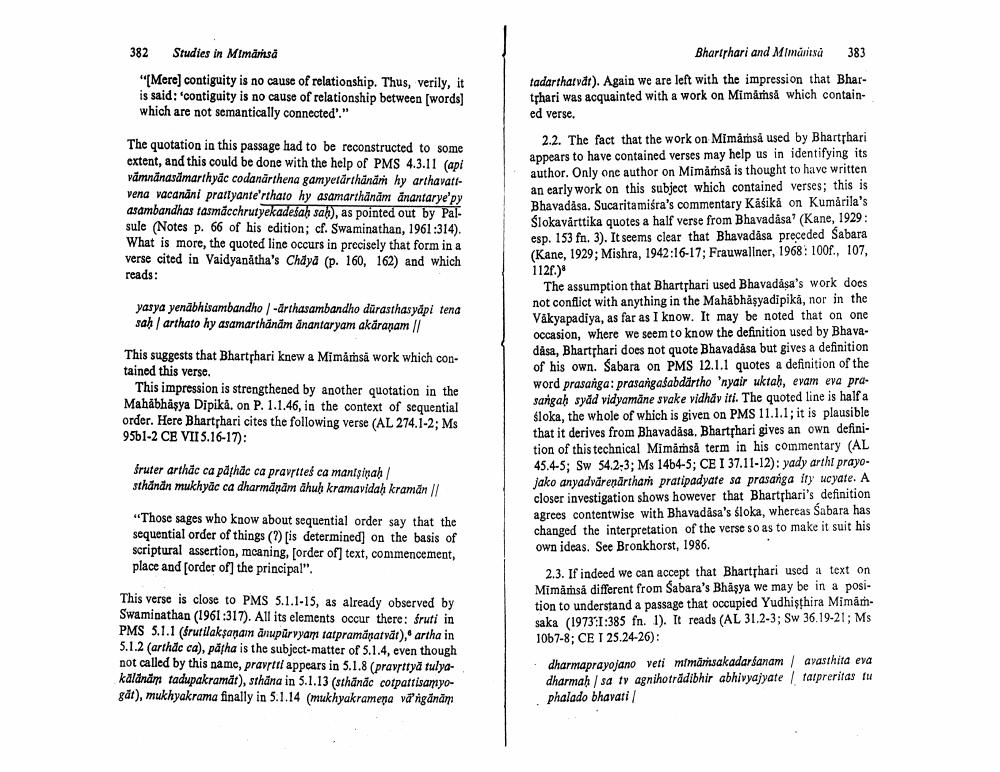________________
382
Studies in Mimarsa
Bharthari and Mimántså
383
"Mere contiguity is no cause of relationship. Thus, verily, it is said: 'contiguity is no cause of relationship between (words] which are not semantically connected'."
tadartharvát). Again we are left with the impression that Bhartrhari was acquainted with a work on Mimams, which contained verse.
The quotation in this passage had to be reconstructed to some extent, and this could be done with the help of PMS 4.3.11 (api vämndnasamarthyac codanarthena gamyetar thánär hy arthavarivena vacanani pratlyante'rthato hy asamarthanam anantarye'py asambandhas tasmacchrutyekadesah sah), as pointed out by Pal sule (Notes p. 66 of his edition; cf. Swaminathan, 1961:314). What is more, the quoted line occurs in precisely that form in a verse cited in Vaidyanatha's Chaya (p. 160, 162) and which reads:
yasya yenābhisambandho/ -arthasambandho dürasthasyapi tena saharthato hy asamarthanam anantaryam akaranam /
This suggests that Bharthari knew a Mimamsa work which contained this verse.
This impression is strengthened by another quotation in the Mahābhäşya Dipika. on P. 1.1.46, in the context of sequential order. Here Bharthari cites the following verse (AL 274.1-2; Ms 95b1-2 CE VII 5.16-17):
2.2. The fact that the work on Mimamsă used by Bharthari appears to have contained verses may help us in identifying its author. Only one author on Mimamsá is thought to have written an early work on this subject which contained verses; this is Bhavadåsa. Sucaritamisra's commentary Käsika on Kumarila's Slokavårttika quotes a half verse from Bhavadása? (Kane, 1929: esp. 153 fn. 3). It seems clear that Bhavadása preceded Sabara (Kane, 1929; Mishra, 1942:16-17; Frauwallner, 1968: 100f., 107, 1121.)*
The assumption that Bharthari used Bhavadasa's work does not conflict with anything in the Mahabhäşyadipika, nor in the Väkyapadiya, as far as I know. It may be noted that on one occasion, where we seem to know the definition used by Bhavadåsa, Bharthari does not quote Bhavadasa but gives a definition of his own. Sabara on PMS 12.1.1 quotes a definition of the word prasanga: prasangasabdártho 'nyair uktah, evam eva prasangah syad vidyamáne svake vidhåv itl. The quoted line is half a śloka, the whole of which is given on PMS 11.1.1; it is plausible that it derives from Bhavadása. Bharthari gives an own definition of this technical Mimamsă term in his commentary (AL 45.4-5; Sw 54.2:3; Ms 1464-5; CEI 37.11-12): yady arthr prayoJako anyadvárenartham pratipadyate sa prasanga ity ucyate. A closer investigation shows however that Bharthari's definition agrees contentwise with Bhavadasa's sloka, whereas Sabara has changed the interpretation of the verse so as to make it suit his own ideas. See Bronkhorst, 1986.
fruter arthac ca pdfhac ca pravsttes ca mantsinah/ sthanan mukhyac ca dharmánām āhuh kramavidah kraman //
"Those sages who know about sequential order say that the sequential order of things (V) is determined) on the basis of scriptural assertion, meaning, [order of text, commencement, place and [order of the principal".
This verse is close to PMS 5.1.1-15, as already observed by Swaminathan (1961:317). All its elements occur there: śruti in PMS 5.1.1 (srutilaksanan anupūrvyan tatpramaşatvat), artha in 5.1.2 (arthdc ca), patha is the subject matter of 5.1.4, even though not called by this name, pravrtti appears in 5.1.8 (pravsttyä tulyakalanän tadupakramát), sthana in 5.1.13 (sthanac cotpartisanyogät), mukhyakrama finally in 5.1.14 (mukhyakramena varganam
2.3. If indeed we can accept that Bharthari uscd a text on Mimämsă different from Sabara's Bhäşya we may be in a position to understand a passage that occupied Yudhisthira Mimamsaka (1973:1:385 fn. 1). It reads (AL 31.2-3; Sw 36.19-21; Ms 1067-8; CEI 25.24-26):
dharmaprayojano veti mimärsakadarsanam/ avasthita eva dharmah / sa tv agnihotrādibhir abhivyajyate / tatpreritas tu phalado bhavati




